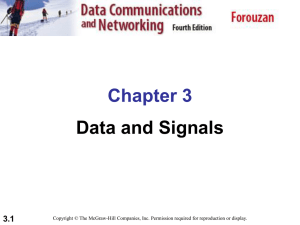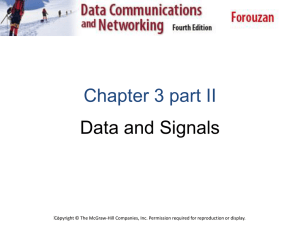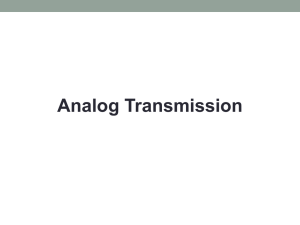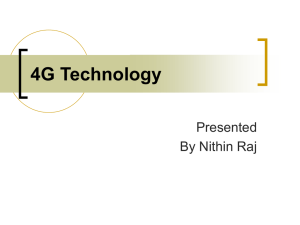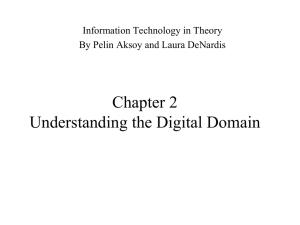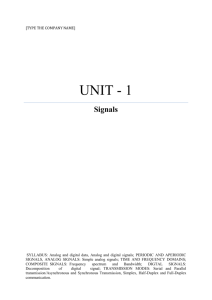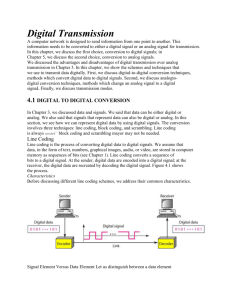Document
advertisement
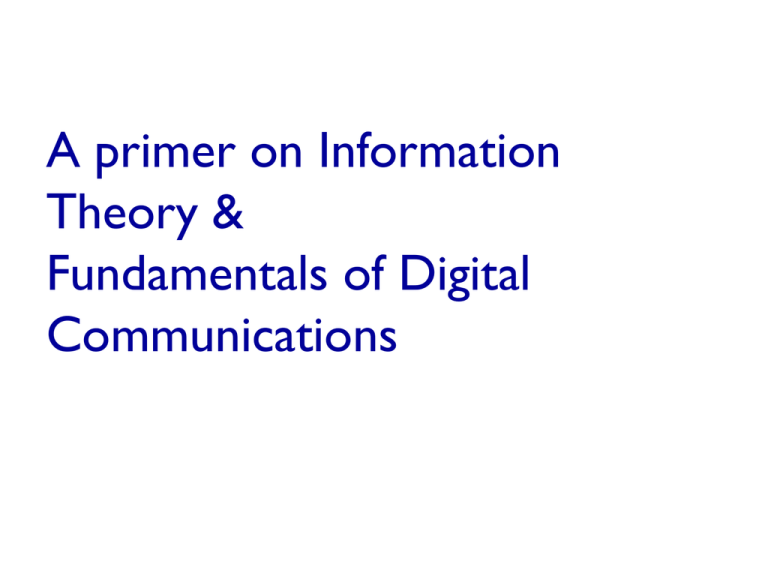
A primer on Information Theory & Fundamentals of Digital Communications Network/Link Design Factors Transmission media Signals are transmitted over transmission media Examples: telephone cables, fiber optics, twisted pairs, coaxial cables Channel capacity and Bandwidth (εύρος ζώνης) Higher channel capacity (measured in Hz), gives higher bandwidth (range of frequencies), gives higher data rate Transmission impairments Attenuation (εξασθένηση) Interference (παρεμβολή) Number of receivers In guided media More receivers (multi-point) introduce more attenuation2 Channel Capacity and data rate Bandwidth In cycles per second, or Hertz (e.g. 10 Mhz bandwidth) Available bandwidth for signal transmission is constrained by transmitter and transmission medium makeup and capacity Data rate Related to the bandwidth capabilities of the medium in bits per second (the higher the bandwidth the higher the rate) Rate at which data can be communicated Baud rate (symbols/sec) ≠ bit rate (bits/sec) • Number of symbol changes made to the transmission medium per second • One symbol can carry one or more bits of information 3 Data Rate and Bandwidth Any transmission system has a limited band of frequencies This limits the data rate that can be carried E.g., telephone cables due to construction can carry signals within frequencies 300Hz – 3400Hz This has severe effect on what signals and what capacity in effect the channel has. To understand this lets consider any complex signal and see if we can analyse its frequency content, and what effect the channel may have on the signal (distortion?) and in effect limit the rate of the transmitted signal (measured in bits/sec) 4 Frequency content of signals http://www.allaboutcircuits.com/vol_2/chpt_7/2.h tml any repeating, non-sinusoidal waveform can be equated to a combination of DC voltage, sine waves, and/or cosine waves (sine waves with a 90 degree phase shift) at various amplitudes and frequencies. This is true no matter how strange or convoluted the waveform in question may be. So long as it repeats itself regularly over time, it is reducible to this series of sinusoidal waves. 5 Fourier series Mathematically, any repeating signal can be represented by a series of sinusoids in appropriate weights, i.e. a Fourier Series. http://en.wikipedia.org/wiki/Fourier_series 6 The Mathematic Formulation A periodic function is any function that satisfies f (t ) f (t T ) where T is a constant and is called the period of the function. Note: for a sinusoidal waveform the frequency is the reciprocal of the period (f=1/T) Synthesis a0 2nt 2nt f (t ) an cos bn sin 2 n1 T T n 1 DC Part Even Part Odd Part T is a period of all the above signals Let 0=2/T. a0 f (t ) an cos(n0t ) bn sin(n0t ) 2 n1 n 1 Example (Square Wave) 1 2 1 1 f (t ) sin t sin 3t sin 5t 2 3 5 f(t) 1 -6 -5 -4 -3 -2 - 2 3 4 5 2 a0 1.5 1dt 1 2 0 1 2 1 an 0.5 cos ntdt sin nt 0 0 2 0 n n 1,2, 0 2 / n n 1,3,5, 1 1 1 bn sin ntdt cosnt 0 (cosn 1) 0 n 2,4,6, 2 n n 0 -0.5 Fourier series example Thus, square waves (and indeed and waves) are mathematically equivalent to the sum of a sine wave at that same frequency, plus an infinite series of odd-multiple frequency sine waves at diminishing amplitude 10 Another example With 4 sinusoids we represent quite well a triangular waveform 11 The ability to represent a waveform as a series of sinusoids can be seen in the opposite way as well: What happens to a waveform if sent through a bandlimited (practical) channel E.g. some of the higher frequencies are removed, so signal is distorted… E.g what happens if a square waveform of period T is sent through a channel with bandwidth (2/T)? 12 The Electromagnetic Spectrum Useful spectrum is limited, therefore its allocation/usage is managed The electromagnetic spectrum and its uses for communication. Note: frequency is related to wavelength (f=1/l) 13 Electromagnetic Spectrum Note: frequency is related to wavelength (f=1/l) which is related to antenna length for radio, capacity, power and distance trade-offs exist, etc… 14 Generally speaking there is a push into higher frequencies due to: efficiency in propagation, immunity to some forms of noise and impairments as well as the size of the antenna required. The antenna size is typically related to the wavelength of the signal and in practice is usually ¼ wavelength. 15 Data and Signal: Analog or Digital Data Digital data – discrete value of data for storage or communication in computer networks Analog data – continuous value of data such as sound or image Signal Digital signal – discrete-time signals containing digital information Analog signal – continuous-time signals containing analog information 16 Periodic and Aperiodic Signals (1/4) Spectra of periodic analog signals: discrete f1=100 kHz f2=400 kHz periodic analog signal Amplitude Time Amplitude 100k 400k Frequency 17 Periodic and Aperiodic Signals (2/4) Spectra of aperiodic analog signals: continous aperiodic analog signal Amplitude Time Amplitude f1 f2 Frequency 18 Periodic and Aperiodic Signals (3/4) Spectra of periodic digital signals: discrete (frequency pulse train, infinite) Amplitude periodic digital signal frequency = f kHz ... Time Amplitude frequency pulse train ... f 2f 3f 4f 5f Frequency 19 Periodic and Aperiodic Signals (4/4) Spectra of aperiodic digital signals: continuous (infinite) Amplitude aperiodic digital signal Time Amplitude 0 ... Frequency 20 Sine Wave Peak Amplitude (A) maximum strength of signal volts Frequency (f) Rate of change of signal Hertz (Hz) or cycles per second Period = time for one repetition (T) T = 1/f Phase () Relative position in time 21 Varying Sine Waves 22 Signal Properties 23 Baseband Transmission Figure 1.8 Modes of transmission: (a) baseband transmission 24 Modulation (Διαμόρφωση) Η διαμόρφωση σήματος είναι μία διαδικασία κατά την οποία, ένα σήμα χαμηλών συχνοτήτων (baseband signal), μεταφέρεται από ένα σήμα με υψηλότερες συχνότητες που λέγεται φέρον σήμα (carrier signal) Μετατροπή του σήματος σε άλλη συχνότητα Χρησιμοποιείται για να επιτρέψει τη μεταφορά ενός σήματος σε συγκεκριμένη ζώνη συχνοτήτων π.χ. χρησιμοποιείται στο ΑΜ και FM ραδιόφωνο 25 Πλεονεκτήματα Διαμόρφωσης Δυνατότητα εύκολης μετάδοσης του σήματος Δυνατότητα χρήσης πολυπλεξίας (ταυτόχρονη μετάδοση πολλαπλών σημάτων) Δυνατότητα υπέρβασης των περιορισμών των μέσων μετάδοσης Δυνατότητα εκπομπής σε πολλές συχνότητες ταυτόχρονα Δυνατότητα περιορισμού θορύβου και παρεμβολών 26 Modulated Transmission 27 Continuous & Discrete Signals Analog & Digital Signals 28 Analog Signals Carrying Analog and Digital Data 29 Digital Signals Carrying Analog and Digital Data 30 Digital Data, Digital Signal 31 Encoding (Κωδικοποίηση) Signals propagate over a physical medium modulate electromagnetic waves e.g., vary voltage Encode binary data onto signals binary data must be encoded before modulation e.g., 0 as low signal and 1 as high signal • known as Non-Return to zero (NRZ) Bits 0 0 1 0 1 1 1 1 0 1 0 0 0 0 1 0 NRZ 32 Encodings (cont) Bits 0 0 1 0 1 1 1 1 0 1 0 0 0 0 1 0 NRZ Clock Manchester NRZI If the encoded data contains long 'runs' of logic 1's or 0's, this does not result in any bit transitions. The lack of transitions makes impossible the detection of the boundaries of the received bits at the receiver. This is the reason why Manchester coding is used in Ethernet. 33 Other Encoding Schemes Unipolar NRZ Polar NRZ Polar RZ Polar Manchester and Differential Manchester Bipolar AMI and Pseudoternary Multilevel Coding Multilevel Transmission 3 Levels RLL 34 The Waveforms of Line Coding Schemes 1 0 1 0 0 1 1 1 0 0 1 0 Clock Data stream Unipolar NRZ-L Polar NRZ-L Polar NRZ-I Polar RZ Manchester Differential Manchester AMI MLT-3 35 The Waveforms of Line Coding Schemes 1 0 1 0 0 1 1 1 0 0 1 0 Clock Data stream Unipolar NRZ-L Polar NRZ-L Polar NRZ-I Polar RZ Manchester Differential Manchester AMI MLT-3 36 Bandwidths of Line Coding (2/3) • The bandwidth of Manchester. Power Bandwidth of Manchester Line Coding sdr=2, average baud rate = N (N, bit rate) 1.0 0.5 0 0 • The N/2 1N 3N/2 2N Frequncy bandwidth of AMI. Power Bandwidth of AMI Line Coding sdr=1, average baud rate = N/2 (N, bit rate) 1.0 0.5 0 0 N/2 1N 3N/2 2N Frequncy 37 Bandwidths of Line Coding (3/3) • The bandwidth of 2B1Q Power Bandwidth of 2B1Q Line Coding sdr=1/2, average baud rate=N/4 (N, bit rate) 1.0 0.5 0 0 N/2 1N 3N/2 2N Frequncy 38 Digital Data, Analog Signal After encoding of digital data, the resulting digital signal must be modulated before transmitted Use modem (modulator-demodulator) Amplitude shift keying (ASK) Frequency shift keying (FSK) Phase shift keying (PSK) 39 Modulation Techniques 40 Constellation Diagram (1/2) A constellation diagram: constellation points with two bits: b0b1 Q Quadrature Carrier 01 11 +1 Amplitue Amplitue of Q component Phase -1 I +1 In-phase Carrier Amplitue of I component 00 -1 10 Chapter 2: Physical Layer 41 Amplitude Shift Keying (ASK) and Phase Shift Keying (PSK) The constellation diagrams of ASK and PSK. Q Q Q Q 01 11 011 +1 0 0 0 1 +1 I -1 1 +1 Q 010 110 001 I -1 +1 00 10 111 I I I -1 000 101 100 (a) ASK (OOK): b0 (b) 2-PSK (BPSK): b0 (c) 4-PSK (QPSK): b0b1 (d) 8-PSK: b0b1b2 (e) 16-PSK: b0b1b2 Chapter 2: Physical Layer 42 The Circular Constellation Diagrams The constellation diagrams of ASK and PSK. Q Q Q +1+ 3 01 11 +1 +1 I -1 +1 -1 - -1 3 I +1+ 3 I -1 -1 00 +1 10 -1 - (a) Circular 4-QAM: b0b1 3 (b) Circular 8-QAM: b0b1b2 (c) Circular 16-QAM: b0b1b2b3 Chapter 2: Physical Layer 43 The Rectangular Constellation Diagrams Q Q +1 +1 +1 0 +1 I 0110 0011 0111 +3 1110 1010 1111 1011 Q +1 Q Q 0010 -1 +1 -1 I -3 -1 +1 -1 +3 I -1 +1 I -3 +1 -1 0001 0101 0000 0100 +1 -1 +3 1101 1001 1100 1000 I -1 (a) Alternative Rectangular 4-QAM: b0b1 (b) Rectangular 4-QAM: b0b1 (c) Alternative Rectangular 8-QAM: b0b1b2 (d) Rectangular 8-QAM: b0b1b2 -3 (e) Rectangular 16-QAM: b0b1b2b3 Chapter 2: Physical Layer 44 Quadrature PSK More efficient use if each signal element (symbol) represents more than one bit e.g. shifts of /2 (90o) 4 different phase angles Each element (symbol) represents two bits • With 2 bits we can represent the 4 different phase angles • E.g. Baud rate = 4000 symbols/sec and each symbol has 8 states (phase angles). Bit rate=?? If a symbol has M states each symbol can carry log2M bits Can use more phase angles and have more than one amplitude • E.g., 9600bps modem use 12 angles, four of which have two amplitudes 45 Modems (2) (a) QPSK. (b) QAM-16. (c) QAM-64. 46 Modems (3) (a) (b) (a) V.32 for 9600 bps. (b) V32 bis for 14,400 bps. 47 2-D signal Bk Bk 2-D signal Ak Ak 4 “levels”/ pulse 2 bits / pulse 2W bits per second 16 “levels”/ pulse 4 bits / pulse 4W bits per second 48 Bk Bk Ak Ak 4 “levels”/ pulse 2 bits / pulse 2W bits per second 16 “levels”/ pulse 4 bits / pulse 4W bits per second 49 Analog Data, Digital Signal 50 Signal Sampling and Encoding 51 Digital Signal Decoding 52 Alias generation due to undersampling 53 Nyquist Bandwidth If rate of signal transmission is 2B then signal with frequencies no greater than B is sufficient to carry signal rate Given bandwidth B, highest signal (baud) rate is 2B Given binary signal, data rate supported by B Hz is 2B bps (if each symbol carries one bit) Can be increased by using M signal levels C= 2B log2M 54 Transmission Impairments Signal received may differ from signal transmitted Analog degradation of signal quality Channel impairements Digital bit errors Caused by Attenuation and attenuation distortion Delay distortion Noise 55 Attenuation Signal strength falls off with distance Depends on medium Received signal strength: must be enough to be detected must be sufficiently higher than noise to be received without error Attenuation is an increasing function of frequency 56 Noise (1) Additional signals, exisiting or inserted, between transmitter and receiver Thermal Due to thermal agitation of electrons Uniformly distributed White noise Intermodulation Signals that are the sum and difference of original frequencies sharing a medium 57 Noise (2) Crosstalk A signal from one line is picked up by another Impulse Irregular pulses or spikes e.g. External electromagnetic interference Short duration High amplitude 58 signal signal + noise noise High SNR t t t noise signal signal + noise Low SNR t t t Average Signal Power SNR = Average Noise Power SNR (dB) = 10 log10 SNR 59 Shannon’s Theorem Real communication have some measure of noise. This theorem tells us the limits to a channel’s capacity (in bits per second) in the presence of noise. Shannon’s theorem uses the notion of signal-to-noise ratio (S/N), which is usually expressed in decibels (dB): dB 10 log10 (S / N ) 60 Shannon’s Theorem – cont. Shannon’s Theorem: C B log2 (1 (S / N )) C: achievable channel rate (bps) B: channel bandwidth For POTS, bandwidth is 3000 Hz (upper limit of 3300 Hz and lower limit of 300 Hz), S/N = 1000 C 3000 log 2 (1 1000) 30Kbps For S/N = 100 C 3000 log 2 (1 100) 19.5Kbps 61


